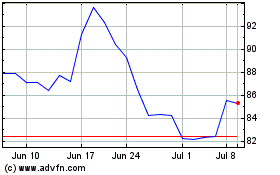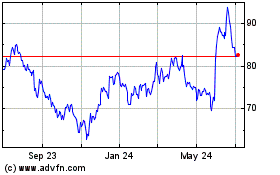GoPro Reports Loss, Predicts Declining Sales
February 03 2016 - 5:30PM
Dow Jones News
GoPro Inc. swung to a surprise loss in its fourth quarter and
gave disappointing revenue forecasts for its new fiscal year, fresh
signs of trouble for the company as it struggles with weak sales of
its latest wearable camera.
GoPro has been pummeled recently by concerns that the market for
action cameras has peaked and questions over its ability to
diversify into other revenue streams, such as consumer drones.
In the holiday quarter, GoPro also was hurt by disappointing
sales of its latest wearable camera: the Hero 4 Session, an
ice-cubed sized camera it launched in July. The camera didn't sell
well, and by December two rounds of price cuts had reduced its
retail price to $199, half the initial $400 price.
"Growth slowed in the second half of the year, and we recognize
the need to develop software solutions that make it easier for our
customers to offload, access and edit their GoPro content," Chief
Executive Nicholas Woodman said in a news release.
GoPro had said in January that it would book special charges in
the fourth quarter related to the price cuts for Hero 4 and excess
inventory and parts. But the size of the charges were about $20
million higher than its initial projections after GoPro decided to
simplify its Hero 4 product offerings.
Those charges helped drive GoPro to a loss of $34.5 million, or
25 cents a share, from a year-ago profit of $122.3 million, or 83
cents a share. Excluding special items, the company's adjusted
per-share loss was eight cents a share. Analysts had expected flat
adjusted earnings.
Revenue fell 31% to $436.6 million. GoPro in January had
forecast revenue of $435 million, well below its October guidance
for revenue of $500 million to $550 million.
For the current quarter, GoPro forecast revenue of $160 million
to $180 million. Analysts had forecast revenue of $298 million. It
expects full-year revenue of $1.35 billion to $1.5 billion, below
the $1.61 billion analysts had forecast.
Shares were halted in after-hours trading after rising 4.6% to
$10.71 in regular trading Wednesday.
Mr. Woodman started GoPro in 2004 so he and other surfers could
photograph their most outrageous stunts. He assembled a prototype
with hot glue and plastic, using rubber bands and a Velcro
surfboard leash to attach it to his wrist. Mr. Woodman landed his
first big retailer, Best Buy Co., six years later.
Amid the concerns over a slowing market for wearables, the
company plans to release a consumer drone later this year, and last
year it began licensing content shot on its cameras to media
companies—an early step toward nascent plans to become a media
company. But neither of those pursuits has yet generated meaningful
revenue.
GoPro also faces mounting competition from overseas
manufacturers and improving smartphone camera technology. Last
month, the company said it would cut about 7% of its workforce and
reduced its revenue forecast for the fourth quarter.
Write to Chelsey Dulaney at Chelsey.Dulaney@wsj.com
(END) Dow Jones Newswires
February 03, 2016 17:15 ET (22:15 GMT)
Copyright (c) 2016 Dow Jones & Company, Inc.
Best Buy (NYSE:BBY)
Historical Stock Chart
From Mar 2024 to Apr 2024

Best Buy (NYSE:BBY)
Historical Stock Chart
From Apr 2023 to Apr 2024
